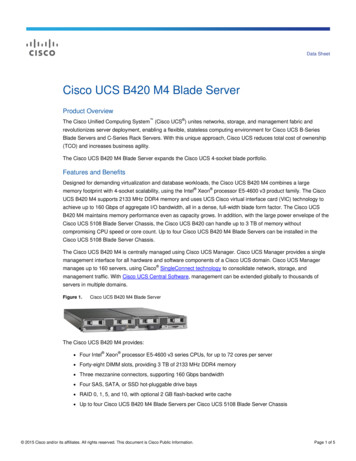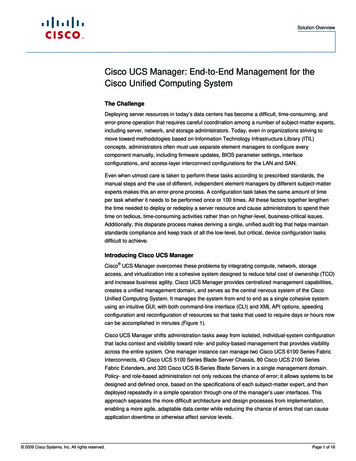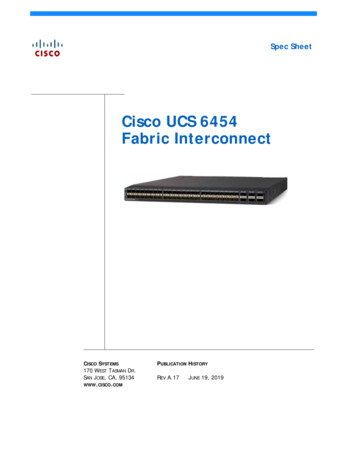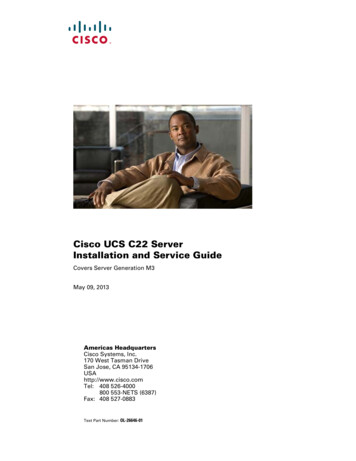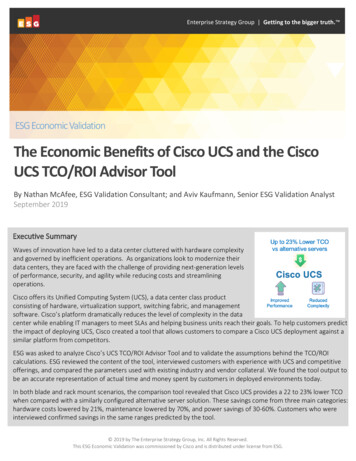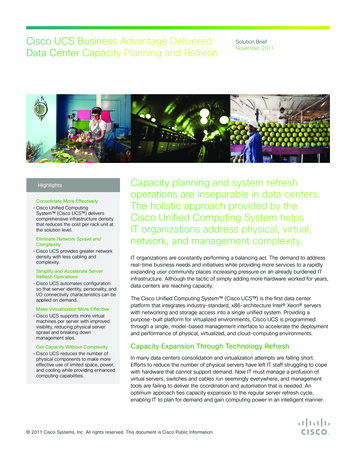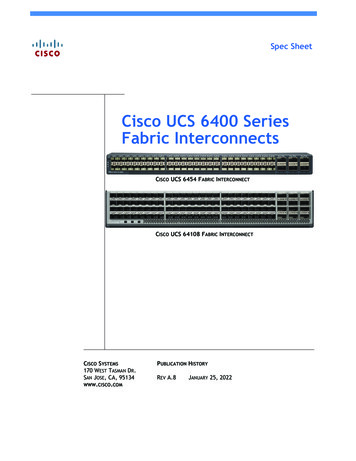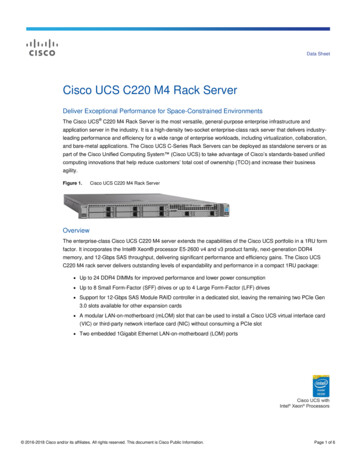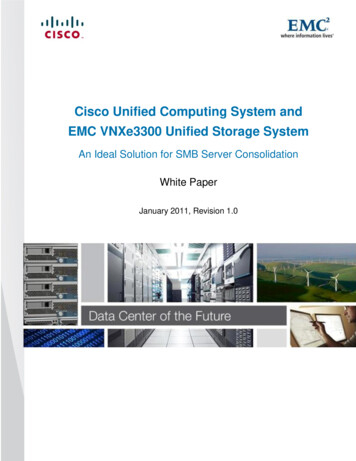
Transcription
Cisco Unified Computing System andEMC VNXe3300 Unified Storage SystemAn Ideal Solution for SMB Server ConsolidationWhite PaperJanuary 2011, Revision 1.0
Contents Cisco UCS C250 M2 Extended-Memory Rack-Mount Server with EMC VNXe3300 is an Ideal Solution forSMB Application Server Consolidation . 3Cisco UCS C250 M2 Extended-Memory Rack-Mount Server . 3EMC VNXe3300 Unified Storage System . 4The SMB Application Server Consolidation Solution Demonstration . 6Running the Simulation Shows the EMC VNXe3300-Cisco UCS C250 M2 Solution Provides Ample Room toGrow . 7Conclusion . 8 2011 Cisco Systems, Inc. All rights reserved. This document is Cisco Public InformationWhite PaperPage 2
Cisco UCS C250 M2 Extended-Memory Rack-Mount Server with EMC VNXe3300 is an Ideal Solution for SMB Application Server ConsolidationA small or medium business can run its critical business applications on the powerful Cisco UCS C250 M2 serverconnected to the low-cost, easy to configure EMC VNXe3300 storage solution. In this paper we demonstrate howcritical web server, database, mail server, file server and Java application server workloads can be consolidatedonto a single Cisco UCS C250 M2 server using VMware ESX 4.1, with the EMC VNXe3300 providing highperformance iSCSI-based storage for the ESX VMFS datastores.Figure 1Cisco UCS C250 M2 Server with EMC VNXe3300 ConfigurationCisco UCS C250 M2 Extended-Memory Rack-Mount ServerThe Cisco UCS C250 M2 Extended-Memory Rack-Mount Server (Figure 2) is a high-performance, memoryintensive, two-socket, two-rack-unit (2RU) rack-mount server designed to increase performance and capacity fordemanding virtualization and large-data-set workloads. It also reduces the cost of smaller memory footprintsthrough the use of lower-cost, lower-density memory modules. The system is ideal for virtualized workloads inenterprise data centers, service provider environments, and virtual desktop hosting environments. The systemalso helps increase performance for large-data-set workloads, such as database management systems andmodeling and simulation applications.Figure 2Cisco UCS C250 M2 Server 2011 Cisco Systems, Inc. All rights reserved. This document is Cisco Public InformationWhite PaperPage 3
The following are the key features of the Cisco UCS C250 M2 Rack-Mount Server: Up to two six-core Intel Xeon 5600 series processors; these multicore processors automatically andintelligently adjust server performance according to application needs, increasing performance whenneeded and achieving substantial energy savings when not Up to 384 GB, 48 dual in-line memory module (DIMM) slots, based on Samsung 40 nm class DDR3memory technology twice as much as similar servers in the industry Up to eight internal SFF SAS or SATA drives for a total of up to 4.8 TB RAID 0 and 1 support for up to eight SAS or SATA drives with the optional LSI SAS30813E-R PCIe RAIDController; and RAID 0, 1, 5, 6, 50, and 60 support for up to eight SAS or SATA drives with the optional LSIMegaRAID Controller Support for up to five PCIe cards in three low-profile, half-length x8 and two full-height, half-length x16slots; all slots use x16 connectors Four integrated Gigabit Ethernet ports and two 10/100-Mbps Ethernet management ports for accessing theCisco UCS Integrated Management Controller Front-panel CD/DVD drive, locator LED, and interface with video, two USB, and serial port connections Back-panel video, two USB, and serial port connectors Increased reliability, availability, and serviceability through optional dual-redundant power supplies meetingClimate Saver specifications and front panel–accessible hot-swap cooling fansEMC VNXe3300 Unified Storage SystemThe EMC VNXe series are ideal storage platforms for SMB’s and SME’s making the move to server virtualizationto drive consolidation and greater efficiency. Members of the VNXe family support unified IP storage operationenabling a single system to simultaneously serve file-oriented (NFS and CIFS) and block-oriented (iSCSI)applications. The VNXe3300 system supports a full complement of enterprise-class storage features and can beeasily expanded - but it is still a simple-to-use and very affordable system. The VNXe series include a powerful management system, Unisphere , which sets a new standard for ease-ofuse. Designed with the needs of the IT generalist in mind, Unisphere delivers a powerful graphical user interfacethat incorporates application-aware management concepts to assist administrators who are not storage experts.Configuration and provisioning wizards are built-in to assist the non-technical user in initial setup and deployment.The VNXe3300 system is based on a redundant and highly-reliable architecture with no single-point-of-failure.The dual controller architecture includes mirrored cache and back-up to flash memory avoiding time-limitedbattery backup or the need for external power supplies. A basic VNXe3300 system can start with a compact,three-rack-unit (3RU) base unit supporting up to 15 disk drives, and the system can be easily expanded by addingup to seven additional 15-drive expansion enclosures.Key features of the EMC VNXe3300 include:Unified storage system consolidates SAN (iSCSI) and NAS (NFS, CIFS) application traffic using a singlecost-effective, easy-to-manage and highly-available platform. Powerful storage management through Unisphere , a graphical, task-oriented GUI that enables systemconfiguration, storage provisioning, system monitoring, alerts, and troubleshooting.Application-aware storage system with built-in configuration and provisioning support for VMwareESX/ESXi, Microsoft Hyper-V, Microsoft Exchange, and shared folders (NFS, CIFS).Available data management features include snapshots, thin provisioning, file de-duplication withcompression, and local/remote replication. 2011 Cisco Systems, Inc. All rights reserved. This document is Cisco Public InformationWhite PaperPage 4
Integrated VNXe ecosystem allows easy access to product information including product documentation,training, help and how-to-videos, troubleshooting, software downloads, and an online knowledgedatabase.Compact 3RU base unit with dual active storage controllers based on quad-core Intel Westmere Xeonprocessors. Each controller includes 12GB of memory and includes mirrored cache.6Gbps serial attached SCSI (SAS) is utilized to interconnect drives and expansion enclosures deliveringhigh performance while simplifying capacity expansion.VNXe3300 consists of a base unit and up to seven expansion drive enclosures, each supporting up to 15Large Form Factor (LFF) 3.5” disk drives, for a maximum of 120 disk drives or 240TB of total (raw)storage capacity.Supported drive types include 300GB and 600GB high performance SAS drives (15K rpm) and 2TB highcapacity Near-line SAS drives (7.2K rpm).Base unit comes standard with eight 1Gbps Ethernet ports and can be expanded with up to fouradditional FlexI/O modules (two modules per controller). FlexI/O modules are available with either four1Gbps Ethernet ports or two 10Gbps optical Ethernet ports.Figure 3EMC VNXe3300-Front ViewFigure 4EMC VNXe3300-Back View 2011 Cisco Systems, Inc. All rights reserved. This document is Cisco Public InformationWhite PaperPage 5
The SMB Application Server Consolidation Solution DemonstrationTo simulate the solution running common applications found in an SMB, a set of representative benchmarkingtools were used (Table 1). There is an e-commerce solution representing a 2-tier OLTP solution where internetusers connect to Apache web servers, which in turn perform transactions on a MySQL database. In this particularexample, there are 3 web server front ends that connect to a single database, representing a scalable solution.The workload for the e-commerce solution was provided by a well-known DVD Store benchmark. The mail serversimulation is a Microsoft Exchange 2007 application running on Windows 2008 Server R2 Enterprise Edition. Thesimulation uses the LoadGen tool to simulate 1000 users. The file server simulation uses 50 threads constantlydoing file operations using the dbench tool to generate the workload. The Java server simulation uses Windows2008 Server R2 Enterprise Edition running a modified (and non-comparable) version of the SPECjbb2005workload.The Cisco UCS C250 M2 server used for the solution was configured with (2) Intel Xeon X5670 processors and196GB RAM. The EMC VNXe3300 was configured with 4x1Gb iSCSI connections and housed (45) 600GB SASdisks.Table 1. Virtual Machine ConfigurationWorkloadOperating systemVirtualProcessorsConfiguredMemoryConfigured StorageMail ServerWindows 2008 Server R2Enterprise Edition48GB72GBFile ServerSUSE Linux Enterprise 10(32-bit)1256MB8GBJava ServerWindows 2008 Server R2Enterprise Edition48GB30GBDatabase ServerSUSE Linux 11 (64-bit)44GB45GBWeb Servers (3)SUSE Linux 112 (ea)2GB (ea)10GB (ea)(64-bit)Figure 5Configuring LUNs with the EMC VNXe3300 2011 Cisco Systems, Inc. All rights reserved. This document is Cisco Public InformationWhite PaperPage 6
EMC VNXe has application integration with VMware ESX, Hyper-V and Microsoft Exchange, making configurationfast and easy.Figure 6Configuring a VMware ESX datastore using EMC VNXe3300Running the Simulation Shows the EMC VNXe3300-Cisco UCS C250 M2Solution Provides Ample Room to GrowThe simulation workload ran at a throttled rate of: 1000 email users on Microsoft Exchange 2007 on Windows Server 2008 R2 Enterprise Edition 50 threads doing random fileserver traffic on SUSE Enterprise Linux 10 98831 Java operations/second 8800 Web orders per minute using apache web servers and a MySQL OLTP database on SUSE EnterpriseLinux 11The Cisco UCS C250 M2 and EMC VNXe3300 resource usage was measured using the esxtop utility that comeswith VMware ESX 4.1. Esxtop showed that the system was untaxed, showing only 30% CPU utilization andoptimal average disk response times of 4ms.Average CPU Utilization30%Average Memory Utilization20 GBAverage ISCSI Response Time4 msGB Storage Used165 GB 2011 Cisco Systems, Inc. All rights reserved. This document is Cisco Public InformationWhite PaperPage 7
Encouraged by the amount of remaining resources, the virtual machines were cloned and the simulation was runwith twice the workload: (2) Microsoft Exchange mail servers, (2) file servers, (2) MySql OLTP databases, (2)Java servers and (6) web servers. Using esxtop to measure system resources during this test shows CPUutilization on the UCS C250 M2 at 65% and iSCSI response time from the VNXe3300 is still a very respectable6ms.Average CPU Utilization65%Average Memory Utilization40 GBAverage ISCSI Response Time6 msGB Storage Used330 GBConclusionIn this white paper we demonstrate how a simple solution consisting of a single Cisco UCS C250 M2 ExtendedMemory Rack-Mount Server running VMware ESX 4.1 connected to EMC VNXe3300 can consolidate numerouscritical SMB applications. These applications include but are not limited to Apache web servers, MicrosoftExchange mail servers, MySQL databases, file servers, and Java application servers. The outstanding computepower and memory capabilities of the Cisco UCS C250 M2 Extended-Memory Rack Mount Server mated withhigh-performance iSCSI-based storage from the EMC VNXe-3300, has the capability to support thousands of ecommerce order transactions per minute, serve thousands of web pages, and support thousands of mail users—all simultaneously, creating an ideal solution for small and medium businesses. 2011 Cisco Systems, Inc. All rights reserved. This document is Cisco Public InformationWhite PaperPage 8
Cisco Systems, Inc.170 West Tasman DriveSan Jose, CA 95134-1706USAwww.cisco.comTel:408 526-4000800 553-NETS (6387)Fax:408 527-0883 2011 Cisco Systems, Inc. All rights reserved. Cisco, the Cisco logo, and Cisco Systems are registered trademarks or trademarks ofCisco Systems, Inc. and/or its affiliates in the United States and certain other countries. All other trademarks mentioned in this documentare the property of their respective owners. (0805R)Document number: UCS-TR100025 2011 Cisco Systems, Inc. All rights reserved. This document is Cisco Public InformationWhite PaperPage 9
The EMC VNXe series are ideal storage platforms for SMB's and SME's making the move to server virtualization to drive consolidation and greater efficiency. Members of the VNXe family support unified IP storage operation enabling a single system to simultaneously serve file-oriented (NFS and CIFS) and block-oriented (iSCSI) .
